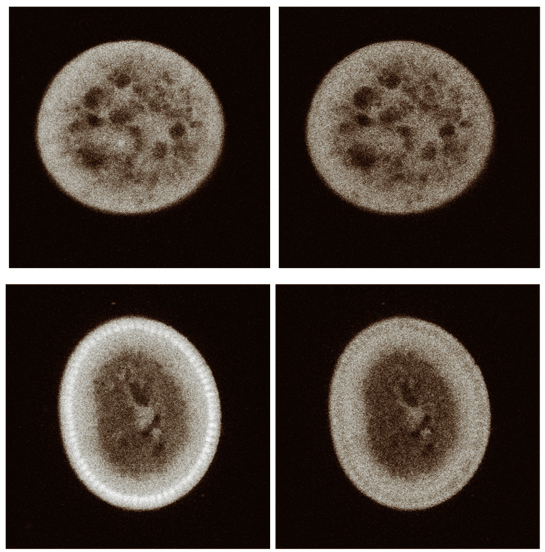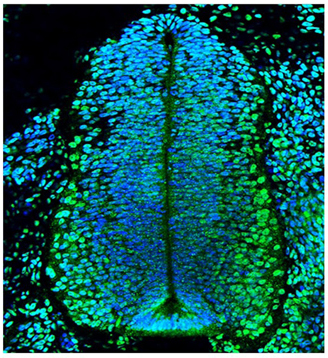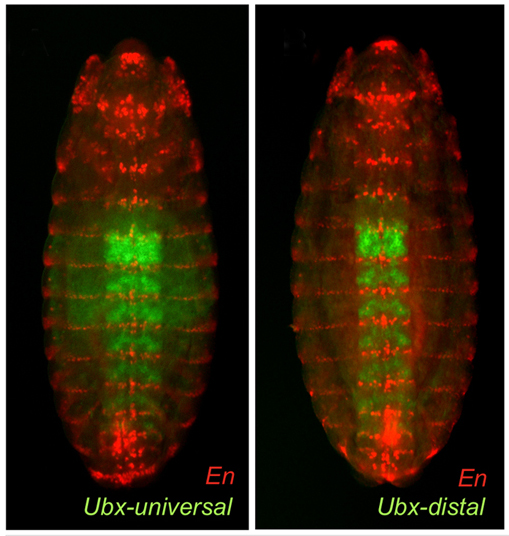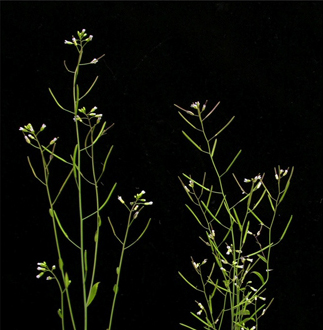In the new issue of Development, 137 (17)…
Posted by Seema Grewal, on 10 August 2010
The Bicoid gradient, epigenetic control of BMP signalling, haematopoietic stem cells and more…here are the highlights from the current issue of Development:
The Bicoid gradient gets into shape without nuclei
 Morphogen gradients provide key positional information during embryogenesis but how they are established is not well understood. A gradient of the transcription factor Bicoid is known to provide Drosophila embryos with positional information along their anterior-posterior axes. Since Bicoid is enriched in nuclei, nuclei have recently been proposed to act as potential traps or sites of degradation that could slow down Bicoid diffusion from the anterior pole and hence contribute to the observed Bicoid gradient. On p. 2857, Oliver Grimm and Eric Wieschaus address this issue experimentally and find that the Bicoid gradient is shaped independently of nuclei. Using mutated Bicoid with impaired nuclear localisation, they show that the resulting gradient of this protein is indistinguishable from that formed by normal Bicoid protein. They also show that the initial centre-to-surface redistribution of Bicoid and the scaling of the gradient are not influenced by Bicoid nuclear accumulation. Based on these findings, the authors propose that nuclei do not play a role in shaping the Bicoid gradient.
Morphogen gradients provide key positional information during embryogenesis but how they are established is not well understood. A gradient of the transcription factor Bicoid is known to provide Drosophila embryos with positional information along their anterior-posterior axes. Since Bicoid is enriched in nuclei, nuclei have recently been proposed to act as potential traps or sites of degradation that could slow down Bicoid diffusion from the anterior pole and hence contribute to the observed Bicoid gradient. On p. 2857, Oliver Grimm and Eric Wieschaus address this issue experimentally and find that the Bicoid gradient is shaped independently of nuclei. Using mutated Bicoid with impaired nuclear localisation, they show that the resulting gradient of this protein is indistinguishable from that formed by normal Bicoid protein. They also show that the initial centre-to-surface redistribution of Bicoid and the scaling of the gradient are not influenced by Bicoid nuclear accumulation. Based on these findings, the authors propose that nuclei do not play a role in shaping the Bicoid gradient.
Spinal cord development BuMPs into epigenetics
 During spinal cord development, transcription factors and signalling proteins, such as the BMPs, are involved in neural tube (NT) patterning and in inducing neural differentiation. Although epigenetic modifications are known to regulate the expression of key neural development genes in stem cells, whether they have a role in spinal cord development remains unclear. On p. 2915, Marian Martínez-Balbás and colleagues study histone H3 lysine 27 trimethylation (H3K27me3) in vivo during chick embryo neurogenesis. They show that global levels of H3K27me3 increase along neurogenesis and regulate BMP signalling within the NT. Using microarray analysis, they find that the expression of Noggin, a BMP inhibitor, is repressed by H3K27me3. Importantly, they show that, in response to BMP activity, the histone demethylase JMJD3 interacts with the Smad1/4 complex to demethylate and thereby activate the Noggin promoter. This reveals a novel pathway by which BMP signalling can regulate its own activity within the spinal cord by modulating expression of its inhibitor Noggin.
During spinal cord development, transcription factors and signalling proteins, such as the BMPs, are involved in neural tube (NT) patterning and in inducing neural differentiation. Although epigenetic modifications are known to regulate the expression of key neural development genes in stem cells, whether they have a role in spinal cord development remains unclear. On p. 2915, Marian Martínez-Balbás and colleagues study histone H3 lysine 27 trimethylation (H3K27me3) in vivo during chick embryo neurogenesis. They show that global levels of H3K27me3 increase along neurogenesis and regulate BMP signalling within the NT. Using microarray analysis, they find that the expression of Noggin, a BMP inhibitor, is repressed by H3K27me3. Importantly, they show that, in response to BMP activity, the histone demethylase JMJD3 interacts with the Smad1/4 complex to demethylate and thereby activate the Noggin promoter. This reveals a novel pathway by which BMP signalling can regulate its own activity within the spinal cord by modulating expression of its inhibitor Noggin.
microRNA regulation of Hox genes: RNA tails matter
 The Hox family of transcriptional regulators plays a central role in specifying segment identity along the anteroposterior axis of animal bodies. The Drosophila Hox gene Ultrabithorax (Ubx) is dynamically expressed during development and controls the development of posterior thoracic and anterior abdominal segments. On p. 2951, Claudio Alonso and colleagues show that during development the Ubx gene produces multiple transcripts that vary in their visibility to microRNAs (miRNAs). They demonstrate that different parts of the embryo express Ubx transcripts that contain variable 3′ UTRs, each harbouring a distinct set of miRNA target sites. The differential distribution of these transcripts during development is independent of miRNA-mediated degradation but is instead due to an in-built system that processes mRNAs according to developmental context. They also show that other Hox genes, such as Antennapedia, abdominal-A and Abdominal-B, exhibit similar developmental RNA processing and propose that developmental processing of 3′ UTR sequences is a general molecular strategy that allows spatiotemporal control of mRNA-miRNA interactions during development.
The Hox family of transcriptional regulators plays a central role in specifying segment identity along the anteroposterior axis of animal bodies. The Drosophila Hox gene Ultrabithorax (Ubx) is dynamically expressed during development and controls the development of posterior thoracic and anterior abdominal segments. On p. 2951, Claudio Alonso and colleagues show that during development the Ubx gene produces multiple transcripts that vary in their visibility to microRNAs (miRNAs). They demonstrate that different parts of the embryo express Ubx transcripts that contain variable 3′ UTRs, each harbouring a distinct set of miRNA target sites. The differential distribution of these transcripts during development is independent of miRNA-mediated degradation but is instead due to an in-built system that processes mRNAs according to developmental context. They also show that other Hox genes, such as Antennapedia, abdominal-A and Abdominal-B, exhibit similar developmental RNA processing and propose that developmental processing of 3′ UTR sequences is a general molecular strategy that allows spatiotemporal control of mRNA-miRNA interactions during development.
Haematopoietic differentiation: lessons from development
Efficient production of haematopoietic stem (HPS) cells from embryonic stem (ES) cells or from induced pluripotent stem (iPS) cells requires a thorough understanding of haematopoietic differentiation pathways. On p. 2829, Gordon Keller and colleagues show that generation of HPS cells from ES and iPS cells follows the same steps as haematopoietic development in the embryo. They induced ES cells with known agonists of embryonic haematopoiesis (activin A, BMP4 and VEGF) and identified two temporally distinct populations of cells expressing the haematopoietic marker Flk1. The gene expression profiles, cell surface markers and lymphoid potential of the early Flk1-positive population resemble those of the first site of embryonic haematopoiesis, whereas the cells that expressed Flk1 at a later stage correspond to a later stage of haematopoiesis. The ability to identify and isolate different stages in the progression from ES or iPS cells to HPS cells will facilitate the study of the generation of blood cell lineages and might improve the efficiency of production of transplantable cells.
Branching out: strigolactones modulate auxin transport
 Shoot branching in plants occurs after bud activation in axillary meristems, which are stem cell clusters along the shoot. This process is repressed by strigolactones by a poorly understood mechanism. One model suggests that strigolactones do not act on the bud directly, but inhibit shoot branching by preventing auxin transport out of the bud. Ottoline Leyser and co-workers now show, on p. 2905, direct evidence in support of this model. The researchers treated Arabidopsis stem segments with a synthetic strigolactone, GR24, and found that this reduced auxin transport. Furthermore, they ruled out a direct effect of strigolactones on bud growth by showing that treatment of a solitary bud with GR24 alone had no effect on bud outgrowth, but that GR24 increased the inhibitory effect of an additional auxin source. In addition, they demonstrated that GR24 enhanced competition between two buds on the same stem. Collectively, these data support the model that strigolactone inhibits shoot branching by regulating the efflux of auxin from axillary buds.
Shoot branching in plants occurs after bud activation in axillary meristems, which are stem cell clusters along the shoot. This process is repressed by strigolactones by a poorly understood mechanism. One model suggests that strigolactones do not act on the bud directly, but inhibit shoot branching by preventing auxin transport out of the bud. Ottoline Leyser and co-workers now show, on p. 2905, direct evidence in support of this model. The researchers treated Arabidopsis stem segments with a synthetic strigolactone, GR24, and found that this reduced auxin transport. Furthermore, they ruled out a direct effect of strigolactones on bud growth by showing that treatment of a solitary bud with GR24 alone had no effect on bud outgrowth, but that GR24 increased the inhibitory effect of an additional auxin source. In addition, they demonstrated that GR24 enhanced competition between two buds on the same stem. Collectively, these data support the model that strigolactone inhibits shoot branching by regulating the efflux of auxin from axillary buds.


 (No Ratings Yet)
(No Ratings Yet)